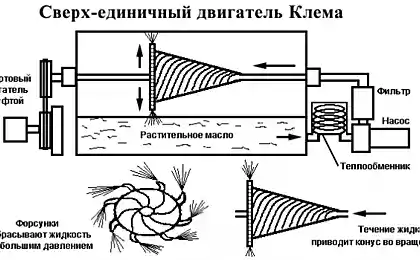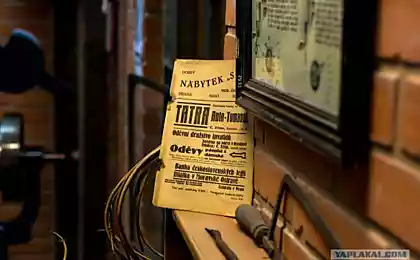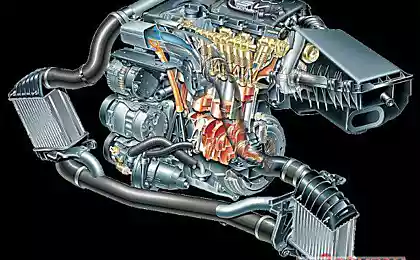555
What we know about ... galoshes?
& quot; - you, ladies and gentlemen, needlessly go without galoshes in such weather - interrupted him didactically Philip Philipovich - first, you catch a cold, and secondly, you have left marks on my carpets and all my carpets are Persian & quot ;. (M.A.Bulgakov. "Heart of a Dog»).
But it was a useful thing. Especially in Moscow slush.
About these powerful rubber products tells LJ ist dedushkin1
9 ph + text

A bit of history galoshes.
The first mention of rubber shoes or a certain similarity, we find it in connection with the Indians. There is evidence that they wetted his shoes sap of the rubber tree. In one version of it from South America got into the idea of Europe, where galoshes first appeared in the early 19th century.

In 1803, they were granted a patent to a man named Radley, who could not recover from a cold, caught them because eternal London slush those years. Out of boredom, he read that "Gallic War" Caesar and learned that the ancient Gauls to protect from dirt wear protective cases for shoes «gallicae». That is what gave rise to the creation of galoshes. The first samples were very uncomfortable, because in the heat of rubber stuck to the shoe and cold cracked.
But everything changed dramatically after the discovery in 1839 the vulcanization of rubber.
In Russia, due to the galoshes there was the following story. In 1859, in St. Petersburg came Ferdinind Krauzkopf German businessman who sold American producers galoshes in Hamburg. Before him there were attempts to make Russian galoshes, but they have not been particularly successful for the same reason - could not vulcanized rubber.
In 1860 Krauzkopf opened TRAM, or Russian-American Association of Rubber Manufactory.

The enterprise produces a large range of rubber products and, of course, "shoe covers." A few months later, the company produced 1,000 pairs of galoshes in the day. And the rate was correct, as the demand for galoshes was very good and constantly growing.
Since 1888 appeared on galoshes brand name - a triangle with the initials of the company inside, with time the word "triangle" is the name of the factory was - "Triangle" (after the revolution - the "Red Triangle").
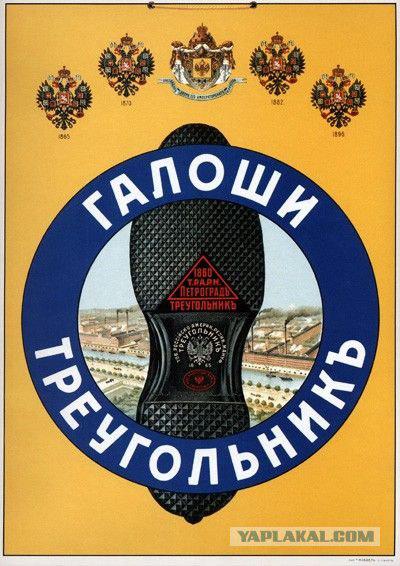
There is evidence that from 1900 to 1912 the release of rubber footwear, namely galoshes grew from 10 million to 20 million pairs a year. At the same quarter of the output was exported to Europe and the United States. Russian galoshes worn throughout Europe.
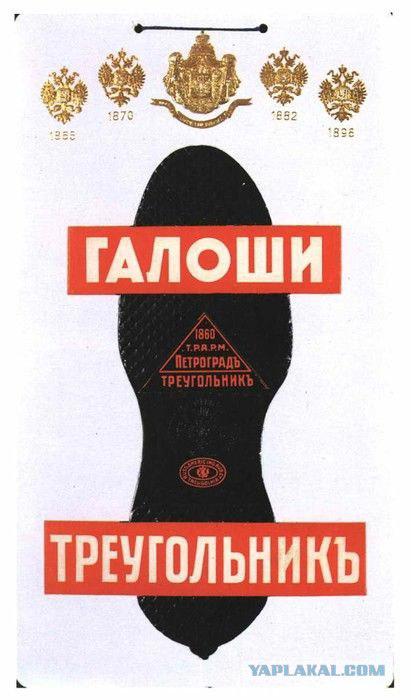
After the revolution, the release of Soviet galoshes began only in 1921, when the "Triangle", and behind him, and Moscow "Bolshevik" resumed work. Demand was huge, goods cost instantly. In the field of advertising the Moscow galoshes worked best creative forces - posters Mayakovsky and Rodchenko forever remain in the history of the Soviet Constructivist design. The desire by all means to increase production often led to a decrease in product quality. This threatened the country's foreign exchange losses - overshoes were export item of the Soviet Union. Mark the "triangle" was well known abroad, but Soviet rubber products do not comply with Western demands. In August 1930, the Board of Trade Mission of the USSR in Germany, directing the works committee of the "Red Triangle" materials on the complaints and wrote: "We discredit in the eyes of foreign buyers of our products so as if our task is not an extension and contraction of markets for our products" .

But all ever comes to an end, and so it came to fashion on galoshes. 50-60-ies. the last century were the last peak of the popularity of galoshes. They are produced for both men and women, with a strap instead of the backdrop and a jack for the heel. But with the advent of shoes on the platform that "elevate" women over dirt galoshes began to leave in the past ... gone, but it looks back.
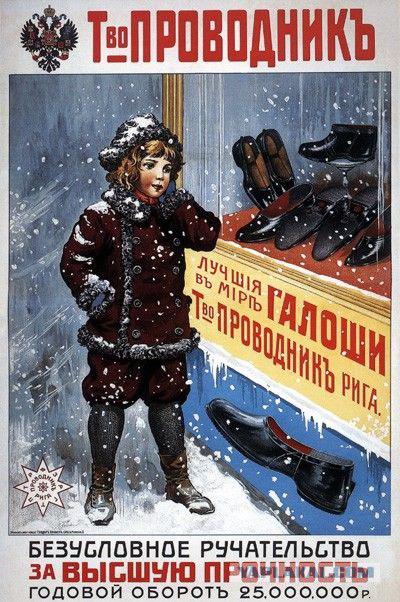
It is not the first time I pay attention that to us returning galoshes. Stylishly dressed young people, and on his feet - overshoes. One saw the yellow, the other green ...
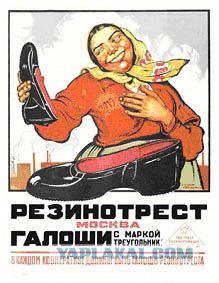
...

Source:
But it was a useful thing. Especially in Moscow slush.
About these powerful rubber products tells LJ ist dedushkin1
9 ph + text

A bit of history galoshes.
The first mention of rubber shoes or a certain similarity, we find it in connection with the Indians. There is evidence that they wetted his shoes sap of the rubber tree. In one version of it from South America got into the idea of Europe, where galoshes first appeared in the early 19th century.

In 1803, they were granted a patent to a man named Radley, who could not recover from a cold, caught them because eternal London slush those years. Out of boredom, he read that "Gallic War" Caesar and learned that the ancient Gauls to protect from dirt wear protective cases for shoes «gallicae». That is what gave rise to the creation of galoshes. The first samples were very uncomfortable, because in the heat of rubber stuck to the shoe and cold cracked.
But everything changed dramatically after the discovery in 1839 the vulcanization of rubber.
In Russia, due to the galoshes there was the following story. In 1859, in St. Petersburg came Ferdinind Krauzkopf German businessman who sold American producers galoshes in Hamburg. Before him there were attempts to make Russian galoshes, but they have not been particularly successful for the same reason - could not vulcanized rubber.
In 1860 Krauzkopf opened TRAM, or Russian-American Association of Rubber Manufactory.

The enterprise produces a large range of rubber products and, of course, "shoe covers." A few months later, the company produced 1,000 pairs of galoshes in the day. And the rate was correct, as the demand for galoshes was very good and constantly growing.
Since 1888 appeared on galoshes brand name - a triangle with the initials of the company inside, with time the word "triangle" is the name of the factory was - "Triangle" (after the revolution - the "Red Triangle").

There is evidence that from 1900 to 1912 the release of rubber footwear, namely galoshes grew from 10 million to 20 million pairs a year. At the same quarter of the output was exported to Europe and the United States. Russian galoshes worn throughout Europe.

After the revolution, the release of Soviet galoshes began only in 1921, when the "Triangle", and behind him, and Moscow "Bolshevik" resumed work. Demand was huge, goods cost instantly. In the field of advertising the Moscow galoshes worked best creative forces - posters Mayakovsky and Rodchenko forever remain in the history of the Soviet Constructivist design. The desire by all means to increase production often led to a decrease in product quality. This threatened the country's foreign exchange losses - overshoes were export item of the Soviet Union. Mark the "triangle" was well known abroad, but Soviet rubber products do not comply with Western demands. In August 1930, the Board of Trade Mission of the USSR in Germany, directing the works committee of the "Red Triangle" materials on the complaints and wrote: "We discredit in the eyes of foreign buyers of our products so as if our task is not an extension and contraction of markets for our products" .

But all ever comes to an end, and so it came to fashion on galoshes. 50-60-ies. the last century were the last peak of the popularity of galoshes. They are produced for both men and women, with a strap instead of the backdrop and a jack for the heel. But with the advent of shoes on the platform that "elevate" women over dirt galoshes began to leave in the past ... gone, but it looks back.

It is not the first time I pay attention that to us returning galoshes. Stylishly dressed young people, and on his feet - overshoes. One saw the yellow, the other green ...

...

Source:










